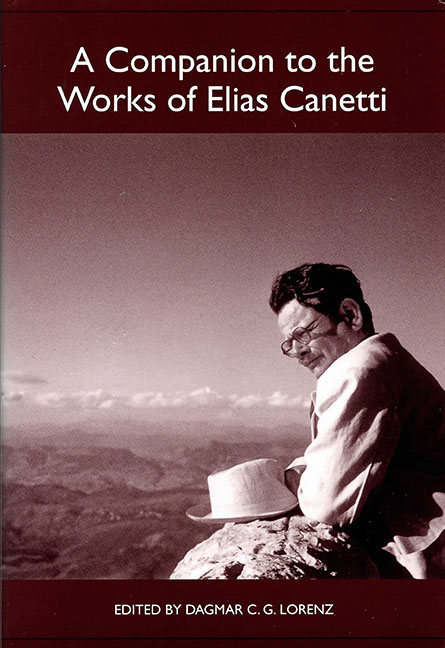Book contents
- Frontmatter
- Dedication
- Contents
- Canetti's Principal Works
- Abbreviations of Works Frequently Cited
- Introduction
- Canetti's Global Significance
- Good-Bye to All That: Elias Canetti's Obituaries
- Writing and Language
- The Works: Themes and Genres
- Philosophy and Social Thought
- Historical Contexts
- Works Cited
- Notes on the Contributors
- Index
Good-Bye to All That: Elias Canetti's Obituaries
from Canetti's Global Significance
Published online by Cambridge University Press: 28 April 2017
- Frontmatter
- Dedication
- Contents
- Canetti's Principal Works
- Abbreviations of Works Frequently Cited
- Introduction
- Canetti's Global Significance
- Good-Bye to All That: Elias Canetti's Obituaries
- Writing and Language
- The Works: Themes and Genres
- Philosophy and Social Thought
- Historical Contexts
- Works Cited
- Notes on the Contributors
- Index
Summary
I began collecting Canetti's obituaries the morning I learned of his death. I was headed to the Stuttgart train station, where one can easily find a whole array of European papers. I bought an armful, even in languages I couldn't read. In the United States it is still too rare a pleasure to find anyone outside of German Studies familiar with Canetti's work. But in Europe his death had made the front pages, not to mention fairly extensive coverage in the arts and culture sections, of virtually all the major papers. When I first planned my errand to the Stuttgart Hauptbahnhof, I did so with the intention of visiting Canetti in the Klosbachstrasse, not of gathering his death notices, or as the Germans more poetically put it, his “Nachrufe.”
Contrary to the posthumous claim that his death was completely unexpected, I knew (or thought I did) that Canetti was ill. He had written to discourage my visit, saying that he expected to be under a doctor's care. Yet I was also familiar with the rumors about his vaunted love of privacy, his reclusiveness, and sometime misanthropy. Erich Fried and Claudio Magris both tell how Canetti, before the age of the answering machine, would screen his Hampstead phone by mimicking the voice of the housekeeper. Others recount how Canetti would simply pretend not to be home if he didn't want to answer the door. So I wasn't sure if the brief note I received was a ploy to evade the intrusions of an overeager academic, or if he was dead serious. I was determined to try my luck, but to no avail: By the time we heard of his death, Canetti had already been buried, as all the newspapers reported, in a Zurich cemetery plot adjacent to James Joyce's grave.
I remember thinking what a coup this was: Canetti had posthumously continued his autobiographical endeavor by arranging an affiliation that would be picked up in even the briefest obituary, thereby ensuring that he would be associated once again with perhaps the century's best known modernist author. Canetti had begun his career to critical notices that frequently associated Die Blendung with Joyce's novels — an observation justified only in the general sense that both Joyce and Canetti are strikingly non-traditional and frankly sometimes demanding.
- Type
- Chapter
- Information
- A Companion to the Works of Elias Canetti , pp. 25 - 42Publisher: Boydell & BrewerPrint publication year: 2004

